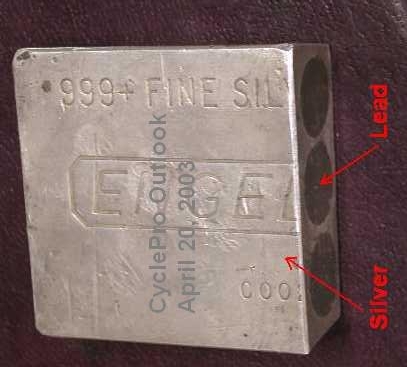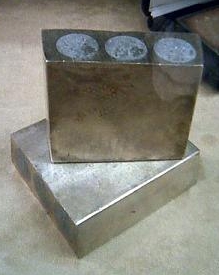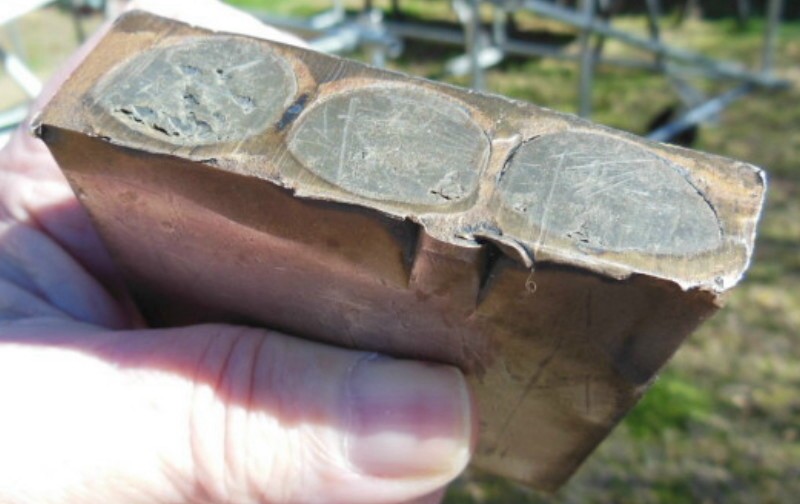About Lead Filled 100 Oz Silver Bars
This page attempts to summarize all information on the Internet about lead-filled 100 ounce silver bars, as well as provide some new thoughts and insight. NOTE: We are actively seeking one of each type of lead-filled Engelhard 100oz silver bar to run tests on, but have been unable to do so. Please if you have a lead-filled Engelhard bar you would sell us or let us borrow (we have no interest in Lyman bars). Thank you!
We also have a page on the pure lead fake Engelhard 100 ounce silver bars.
[Also, a quick note about Lyman Silver Bars -- there is no such thing. These bars, with just the word LYMAN in big letters (the "N" sometimes backwards), are home-made bars, almost always bars of lead. They do not have a metal, weight, or fineness listed on them. Individuals typically use these when making their own sinkers for fishing or bullets. Lead is highly poisonous when inhaled or ingested. Lead melts at 328 degrees Celcius (621 degrees F), while silver does not melt until 962 degrees Celcius (1763 degrees F). Between that and the value of silver, it is very unlikely that someone would melt silver into these molds. You can see the molds for sale here and in their catalog on p56 (p58 in pdf).]
Summary
Lead-filled silver bars apparently first started appearing in the early 1980s, as the price of silver skyrocketed. The bars started off as real 100 ounce silver bars. Someone then removed much of the silver, and replaced it with another metal, probably either lead or a lead-tin alloy with the same weight as silver. Unfortunately, there is little credible information available (for example, some people claim that they have only heard of this happening with Engelhard bars, but that may be because the 2 pictures of such bars happened to be Engelhard bars).
What Do They Look Like?
Unfortunately, the two lead-filled bars that pictures are available of do not show the ends of the bars. According to reports, they are nearly indistinguishable from real bars. However, those same sources also claim that most such bars have been 'removed from circulation' -- but that would be nearly impossible to do unless they were somehow detectable. So it is likely that there would be some sort of evidence of tampering to a trained eye.Over time, pictures of several different lead-filled 100 ounce bars have surfaced on the Internet. The picture on the top left, posted in 2003, is from a 100 ounce silver bar from 'the 1980 silver bull market'. The picture shows half of the bar, which had been cut in half to verify that there was lead in it. You can clearly see 3 holes that had been drilled into the bar. The description of that bar states that the outside of the bar looked completely normal and 'testing by weight did not reveal the hidden deception'. Unfortunately, no other pictures were shown (such as the end of the bar that the holes were drilled into). Apparently, the 'ring test' would work (to a 'very keen ear'). The author was told that all known bogus bars made in the 1980s were removed from circulation (but, of course, that cannot be true; if there were some out there, there still will be).
The bars pictures on the bottom were hollowed out, and then filled with lead (or lead/tin slugs per one source).
The description of the bars on the bottom (hollowed out) also state that the weight was exact, and that they were polished smooth (presumably nearly indistinguishable from real bars).
Can They be Detected by Looking at Them?
Maybe.Some sources say that they are virtually indistinguishable. Someone claiming to have been in the precious metals refining business for 40 years said " In each case, this plug was on the end of the bar and could be seen by careful examination. They ground it down flush but you could still see it."
New information: According to the FBI, they showed Engelhard and U.S. Mint employees samples of the Type II (hollowed out) bars, and they were not able to identify them as adulterated.
When Did These First Appear?
They apparently started appearing in the early 1980s, as the price of silver skyrocketed.
How Are They Made?
First, a real 100 ounce silver bar is obtained. Then, some of the insides are removed (either with 3 drill holes, or some other method). Next, lead or a lead alloy (such as 80% lead, 20% tin) is placed inside the bar (melted would work best, otherwise slugs could be placed inside, but they would cause a lot of air and make it more likely the lead could be detected). Then, silver is added to the open end of the bar.Finally, the bar is smoothed/polished and weighed, to both look as much like the original bar as possible (hiding any evidence of tampering), and keeping the weight as close to exactly 100 ounces as possible.
Then, the person doing this would need to find a way to sell the bars, and find a buyer for the silver shavings as well.
For more details, you can check out our page on Type II Bars.
How Much Do They Weigh?
They are reported to weigh the same as real bars. This would be fairly easy to accomplish, for someone with the skills to handle the rest of the job.
How Common Are They?
There are estimates in the rumor mill that 1 in 25 to 1 in 40 of the 100 ounce silver bars being afflicted with this problem. However, these all appear to be just that: rumors. If true estimates, these may have been estimates made in 2010, or in 1980. We estimate that Engelhard made about 2,000,000 100 ounce bars; that would mean that 50,000 to 80,000 were lead filled (5 to 8 million ounces). It would be very, very difficult for an organization to move that many silver bars unnoticed and untraced.Another person who claims to have worked many years in the refining business says that he has only seen 2-3 lead filled 100 ounce bars out of 1000s that he was involved with.
In the FBI Case, it was claimed that about 150-200 bars were created (of which 16 were recovered), meaning that at least 150 or so such bars made it into circulation (and as many as 500 or so, per our calculations, based on their purchases of lead). Common sense dictates that it is likely that several people did this on a similar scale, so perhaps 1,000 or so bars made it out there (likely many of which have since been discovered). That would be about .05% of all Engelhard 100 ounce bars being tainted, or a 1 in 2,000 chance of having one.
Another point: major online bullion dealers do not place much emphasis on lead-filled 100 ounce silver bars. If they were as prevalent as some suggest (1:25 to 1:40), they would have lots and lots of customers sending in bogus bars (many send in 10+ at a time). Those customers would certainly start complaining, but there aren't any complaints of anyone sending 100 ounce silver bars to major online dealers that told them that they were filled with lead. This makes the ~1:2,000 estimate seem more accurate.
How Much Pure Silver Is In Them?
Even if you do end up with one of these bars, it will contain roughly 25-32 (hollowed out) or about 45 ounces (3 drill holes) of pure silver. From the picture of the bar with the 3 drill holes, we calculate that the bar would be roughly 56% lead if the columns went all the way through, but they do not go all the way through (however, we also calculated based on the bar being a rectangle, whereas it is not). So we estimate 45 ounces for the 3-drill-hole version. For the hollowed out version, we're going on the poster's statement that the assay suggested about 25% silver, which seems about the minimum amount that would need to be left to ensure that it was not damaged enough to be noticeable as an obvious fake. From an assay of 15 hollowed-out (Type II) bars, we calculate that they contained an average contain 31.6oz of silver each.
Would Pure Lead Be Used?
Since pure lead is slightly heavier than silver, an alloy would likely be used, with lead and another metal such as tin. That way, the density would match that of silver. Silver has a specific gravity of 10,490 kb/cuM, and lead has a specific gravity of 11340 (for reference, gold is 19320, platinum 21400, tungsten 19600, copper 8930, tin 7280). Lead is 8.1% heavier than silver. Tin is 30.6% lighter than silver. Using a trial-and-error computer program we come up with 79.075% lead and 20.925% tin (lead's 11340*.79075=8967.1, tin's 7280*.20925=1523.34, add them and you get silver's 10,490). Rounding to 80% and 20% gives you a specific gravity of 10,528, or 0.3% higher than silver, which is close enough to work with.So if it used a tin-lead alloy, it would likely be exactly 80% lead and 20% tin.
However, one person claims that the bars he saw were filled with pure lead. And, the "Type II" hollowed-out bars appear to have been made from pure lead (based on receipts we have copies of, and no information suggesting an alloy).
Can a Magnet Detect These?
The standard 'magnet test' won't work (where some types of costume jewelry, for example, that may appear to be silver, but are not, will be attracted to a magnet). That's because silver and lead are both considered 'diamagnetic' (they repel magnets).Although both silver and lead are diamagnetic, the level of diamagnetism is slightly different. Therefore, it may be possible to detect a lead-filled silver bar either with a strong magnet, or if not, with a Magnetic Susceptibility Meter. Magnetic Susceptibility Meters cost about US$3,000 at this time. It is not known for certain if these would detect lead-filled silver bars.
If you have a strong magnet, and place a 100 ounce silver bar at a 45 degree angle, the magnet should slide slowly down the bar (much slower than it would on, say, a book at a 45 degree angle). In the 3-drilled-holes type of lead-filled silver bar, it's possible that you would notice a change in the speed if you did this (with the bar sideways, so the magnet would go down the short side of the bar, not the long side).
For the curious, the molar susceptibility of lead is -23, silver is -19.5, and tin is -37.4. An 80% lead and 20% tin alloy, if it has the same magnetic properties in proportion to the amounts of each metal, would have a molar susceptibility of -25.9, about 30% more than silver.
Will the Ring Test Work?
Without samples to test with, we can't say for sure. The person posting the 3-hole picture stated that he was told that it could be detected with a 'very keen ear.' So it may be possible.However, be aware that the ring test doesn't always work for real silver! For example, a 100 ounce J&M silver bar was cut in half (by silverstockreport.com) because it didn't pass the ring test, but it turned out to be pure silver.
Can X-Rays or XRF Detect These?
It is possible for x-rays can detect these, according to documents we obtained from the FBI (using non-destructive x-ray equipment of the U.S. Navy). It appears that they used standard x-rays (in the same manner as doctors and dentists do), rather than XRF. There are some people that claim that XRF may not be able to penetrate the silver layer on top of the lead; there are others that have used XRF that claim that it can easily detect the lead. As with many silver-related topics, it isn't clear! We believe that XRF would not detect the bars.
Can Ultrasound Detect Them?
Perhaps -- we are still awaiting verification.In theory, an ultrasonic thickness gauge should detect the lead-filled silver bars. Sound travels at different velocities through different materials, and echoes when it hits a different material. In normal usage, an ultrasonic thickness gauge would be used to measure the thickness of a silver bar. If sound travels through silver at 1 inch per second, and it takes 2 seconds for an echo to come back on a silver bar, the bar is 1" thick (since the sound goes through the silver from the top to the bottom, and then the echo goes from the bottom to the top, so the sound travels 2" if the silver bar is 1" thick).
Ultrasonic thickness gauges are usually used to determine the thickness of something you have access to only one side of (such as the metal wall of an oil tank). But here, we have access to all sides of the silver bar, and therefore we already know the thickness of it (about 27mm, or 1 1/16").
So, when calibrated for silver, you would place the probe (transducer) of the ultrasonic thickness gauge on the silver bar, and if it is real silver, the ultrasonic thickness gauge should show the thickness as about 27mm (perhaps around 25-29mm, accounting for a high error level, in case the bar is slightly thicker or narrower than normal; the gauges are typically accurate to .01mm if calibrated properly).
Sound travels through silver at 3600 meters/second, and through lead at 2200 meters/second. That means that sound travels about 40% slower through lead than silver. So if you measured a 27mm thick lead bar, and the gauge was calibrated for silver, it would show up as being 63% thicker (3600/2200), or 44mm. The doctored bars aren't pure lead, though.
If you have a lead-filled silver bar, our thoughts are that one of the following would occur (from most likely to least likely):
- The sound would bounce off the lead, and the thickness shown would be that of the silver layer on top (perhaps about 4mm).
- The sound wouldn't properly bounce off of the lead (perhaps due to air pockets around lead, rough edges, etc.). In this case, the gauge would report an error.
- The sound would go through the whole bar, bounce off of the table or whatever else you placed the bar on, and the thickness would show as the actual silver thickness plus 1.63x the lead thickness. In this case, 8mm of silver plus 19mm of lead, but the 19mm of lead looks like 31mm to the gauge, so we would see 39mm as the thickness.
- The sound would go through the lead, but bounce off of the next layer of silver. In this case, the thickness shown would be noticeably off (4mm silver plus 19mm lead, but the 19mm lead would show up as 31mm, so it would show as 35mm thick).
Note that an 80% lead 20% tin alloy would handle sound differently; sound travels through lead at 3300 meters/second. If sound travels through the alloy proportionately to the amount of each material, that would mean sound would travel through the alloy at 2,420 meters/second (3300 minus 2200 is 1,100 times 20% tin is 220 plus lead's 2200 is 2,420). That's 33% slower than silver, with 1" of lead measuring as 1.36" of silver. In that case, numbers for the last two scenarios about would be different (34mm and 30mm). That is still 10% thicker than the bar actually is.
Also, at some points in the bar, the thickness would be 100% silver. So you would need to be sure to measure where the lead is, at its maximum thickness. If taking just one measurement, doing so at the exact center of the bar would get the maximum lead thickness for the two types of bars in the pictures at the top of the page.
(C) Copyright 2010-2019 About.Ag





